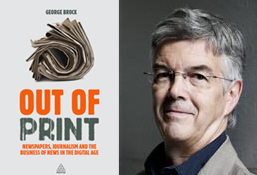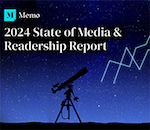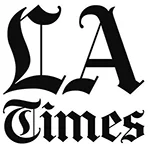U.K. author George Brock enthused about journalism’s future March 26 at NYU. However, there are only 67K jobs in print/broadcast in the U.S. but 229K PR jobs (U.S. Bureau of Labor Statistics).
Current grads have a much better chance of making a living in PR than journalism.
 |
Brock, author of Out of Print, a 242-page expression of hope for journalism, addressed a youthful audience of more than 100 on the topic: “Journalism: Bullish on the Future.” Host was the Center for Communication.
He concedes that tens of thousands of newspaper jobs have been lost in the U.S. and U.K. and that the downslide will continue. But he feels that online sites such as BuzzFeed, Gawker, Gothamist, Curbed, TPM, Record, NowThis, Storyful, Thunderdome, Racked and others will fill some of the gap, although many attempts at online journalism will fail.
BuzzFeed, based at 200 Fifth Ave., New York, is supported by $46 million in venture capital, writes Brock, who says its use of advertorials “is liable to compromise claims to editorial independence.” Total employment is 450 with offices also in Los Angeles, Washington, D.C., San Francisco, Chicago, London and Sydney. The newsroom employs about 160 reporters and editors. Ben Smith is editor-in-chief. BuzzFeed Video employs more than 40 producers based in L.A.
Panelist Steve Waldman, formerly with US News & World Report and Newsweek and senior advisor to the chairman of the FCC, said he looks forward to the day when BuzzFeed gives “its guy in Kabul” as much play as it does to the latest cats video that cost three cents to produce and gets “zillions” of viewers.
“Big Boobs” a Winner at BuzzFeed
 |
The March/April Columbia J Review, which has seven pages on digital journalism, noted that BuzzFeed managing editorial director Summer Anne Burton, who supervises a staff of 35, became a star with her “29 Struggles That Only People with Big Butts Will Understand.” It drew 4.8 million views in its first week.
Another “smash hit” of hers was “28 Things that People with Big Boobs Can Simply Never Do.”
What shocked us was Forbes contributing editor Max Robins saying Forbes pays him based on how many clicks his articles draw. He said the same thing to a Cencom audience Oct. 8, 2013 at the New School.
We found a detailed description of the Forbes “contributor payment plan” on its website. It says writers get a “flat monthly fee, a bonus for hitting certain unique visitor targets, and a fee per unique user after bonus targets are achieved.” A certain number of posts are required per month and a specific level of audience engagement (the precise terms are “a matter between Forbes and the individual contributor”). Forbes has blocked a direct link to this description.
Drawing audience is the main game of BuzzFeed writers, Burton told CJF reporter Marc Fisher: “The goal is the same whether you’re writing about big butts or Bill Gates. You have to write what people want to read.”
Needless to say, traditional journalists are alarmed that the value of their output should depend solely on audience pull. Among them is Harper’s columnist Thomas Frank who feels journalists are being reduced to itinerant day laborers who get paid according to how many berries they pick.
The “content mills” being run by publishers such as Demand Media are “an inventive way to minimize labor costs—a temp agency for writers, a literary maquiladora,” says Frank. Numerous media including USA Today are building an “army of freelancers” to keep costs to a minimum, he writes.
Far More Jobs in PR than J
We were given a mike that was being passed around at the NYU session and told the audience that the odds of forging a successful career in PR were much greater than the odds of making much money in journalism. J jobs have shrunk to 67,000 in the U.S. while PR jobs have grown to 229,000 and constitute “one of the fastest growing” categories, according to the U.S. Bureau of Labor Statistics.
We noted that nearly half of the 127 firms in the 2013 O’Dwyer rankings grew at double figures and offered a free O’Dwyer’s Directory of PR Firms to anyone who came by the office.
It’s far easier to open a PR firm that offers nearly endless promotional and communications services to local businesses than to start a J website that will produce any income, we noted.
If moderator Robins had not ordered the mike to be taken from our hands, saying “no speeches” were allowed, we would have noted that there is no need for cash-rich businesses to be starving newspapers or other media.
Apple Had $135B in Cash
Apple gained notoriety last year when it became known that the company had $135 billion in cash. It simply did not know what to do with all this money. A large part of it was overseas. Apple did not want to pay the taxes required if the funds were brought to the U.S.
Newspaper ad revenues declined from $49.2B in 2006 to $22.3B in 2012 (2013 figures are not yet available). The shortfall, which cost tens of thousands of journalists their jobs, was $26.9B—a small fraction of the $135B pot at Apple. That pot is currently $40 billion since the company has paid dividends and bought back some of its own stock.
Forbes contributor Louis Woodhill had a column Jan. 1, 2014 titled: “Why American Companies Are Holding Onto $5 Trillion in ‘Cash.’”
His explanation: “People and companies are holding more cash because there is more cash to hold.” By “cash” he meant “highly liquid, risk free, dollar-denominated assets.”
“Real, productive investment is far below the levels needed for robust economic growth,” says Woodhill.
Why can’t companies invest some of this in the U.S. newspaper industry, the bulwark of U.S. democracy?
It could be ads, site licenses or a number of things.
Newspapers are being starved to death by rich business interests which then pick up the carcasses for a fraction of their former prices, the Washington Post and Boston Globe being examples of this.
We wonder if anyone at NYU March 26 ever heard of Omnicom, WPP Group, Interpublic and Publicis, ad conglomerates that employ 280,000 and whose media buying units hold life and death power over media. Omnicom and Publicis are merging to create a company with nearly $25 billion in revenues. Since the $25B represents commissions at 10-15%, the actual value of space and time being purchased by OMC/Publicis alone is worth upwards of $250B.
We doubt they are aware that OMC CEO John Wren and COO Randy Weisenburger, whose pay packages totaled $84.5 million in 2012, sued small stockholder John Chevedden who has been a critic of such packages. NYT has not covered this story. WPP’s Martin Sorrell is among the highest paid execs in the U.K. and in one year was No. 1. A 60% majority of stockholders voted against the 2012 package. A revised package was approved in 2013.
USA Today media columnist Michael Wolff told Columbia J School students last year that if they don’t make enough money, they are not going to be happy.
The odds of making good money are much higher in PR than in journalism, although PR requires a different mindset than journalism.
Makovsky Berates GM’s Barra
Among Forbes contributors is Ken Makovsky, CEO of the New York firm in his name.
He has written three columns busting on GM CEO Mary Barra for not having a proper press conference on the recall issue.
The first one asked “Where is GM’s CEO?” while the second one said GM was taking a “cowardly approach” and the third said, “GM Still Reticent on its Recall Response.”
Barra’s “press conference” March 18 was a 45-minute on-the-record session in GM offices to which 13 major media were invited but which was not videotaped.
It is a far cry from U.S. Presidential press conferences or the press conferences that were held in 1979 after the Three Mile Island nuclear radiation leak.
The press conference has just about disappeared from the U.S. business/press scene, a development that is weakening the press almost as much as the stingy attitude rich companies have taken towards newspapers. Press conferences are the chance for the press to cross-examine business and other leaders in a public setting.
PRSA Leaders Should Face Press on Murray
Giving a bad example to its 22,000 regular members and 10,000 student members is the world’s biggest PR association—PR Society of America. Its leaders have not had a press conference since the one held in 1993 at the annual meeting in Orlando.
Makovsky should urge that 2014 chair Joe Cohen, treasurer Mark McClennan, VP-PR Stephanie Cegielski, and resigned CEO Bill Murray to face the PR press on the sudden resignation of Murray and answer questions on the Society’s plans for this post in the future. Three of the last four appointees were association professionals who were not even members of the Society. The exception was Cathy Bolton, a career PR person who was hired to do PR but who became COO in 2001 after Ray Gaulke suddenly resigned with four years to go on his contract.
The Society leaders should also be asked to divulge the current bank balance of the Society and the pay of staffers making more than $100,000.


 Trump Media & Technology Group today reported a $58.2M net loss on $4.1M in 2023 revenues, a disclosure that drove its stock price down 22.6 percent to $47.96.
Trump Media & Technology Group today reported a $58.2M net loss on $4.1M in 2023 revenues, a disclosure that drove its stock price down 22.6 percent to $47.96. Barry Pollack, an attorney at Wall Street’s Harris St. Laurent & Wechsler, has registered Julian Assange as a client with the Justice Dept. “out of an abundance of caution.”
Barry Pollack, an attorney at Wall Street’s Harris St. Laurent & Wechsler, has registered Julian Assange as a client with the Justice Dept. “out of an abundance of caution.” Paramount Global to slash 800 jobs in what chief executive Bob Bakish calls part of an effort to “return the company to earnings growth"... Rolling Stone editor-in-chief Noah Shachtman is exiting at the end of the month due to disagreements with chief executive Gus Wenner over the direction the magazine is taking... The New York Times broke the $1 billion barrier in annual revenue from digital subscriptions in 2023... Press Forward is investing more than $500 million to strengthen local newsrooms.
Paramount Global to slash 800 jobs in what chief executive Bob Bakish calls part of an effort to “return the company to earnings growth"... Rolling Stone editor-in-chief Noah Shachtman is exiting at the end of the month due to disagreements with chief executive Gus Wenner over the direction the magazine is taking... The New York Times broke the $1 billion barrier in annual revenue from digital subscriptions in 2023... Press Forward is investing more than $500 million to strengthen local newsrooms. The majority of news articles are read within the first three days of publication, according to a recent report.
The majority of news articles are read within the first three days of publication, according to a recent report. The Los Angeles Times gives pink slips to 115 people or 20 percent of its newsroom staff... TIME is also laying off about 30 employees, which is approximately 15 percent of its editorial staff... The Baltimore Banner, which was launched by Stewart Bainum in 2022 after he failed to buy the Baltimore Sun, added 500 subscribers per day in the three days following Sinclair Broadcast Group's deal to purchase the Sun.
The Los Angeles Times gives pink slips to 115 people or 20 percent of its newsroom staff... TIME is also laying off about 30 employees, which is approximately 15 percent of its editorial staff... The Baltimore Banner, which was launched by Stewart Bainum in 2022 after he failed to buy the Baltimore Sun, added 500 subscribers per day in the three days following Sinclair Broadcast Group's deal to purchase the Sun.


 Have a comment? Send it to
Have a comment? Send it to 
No comments have been submitted for this story yet.